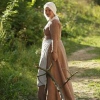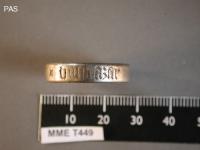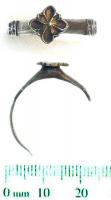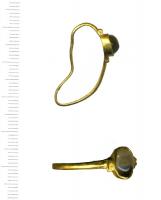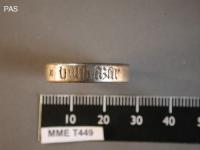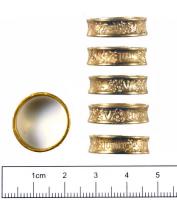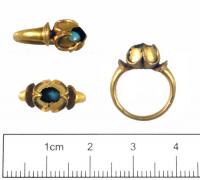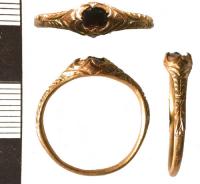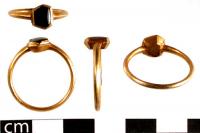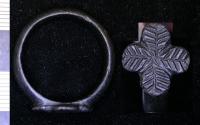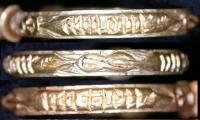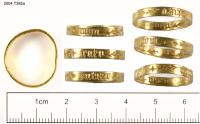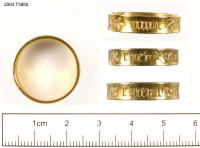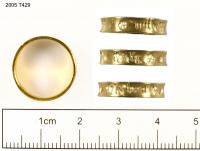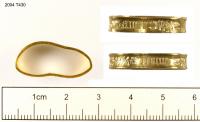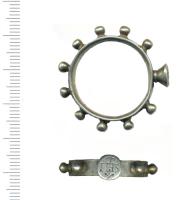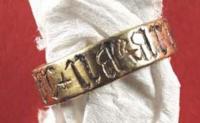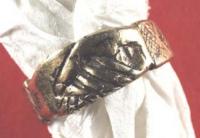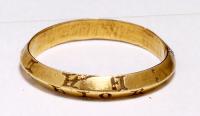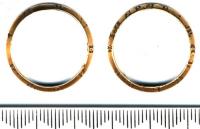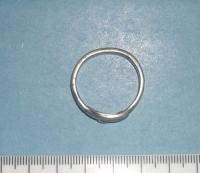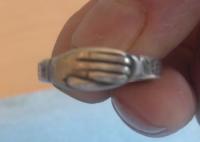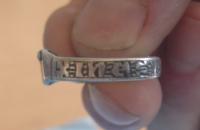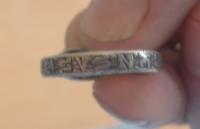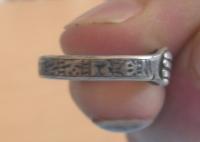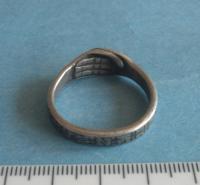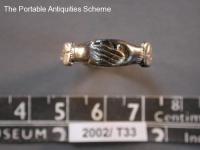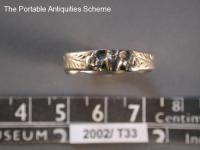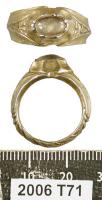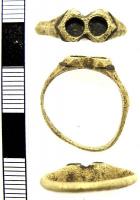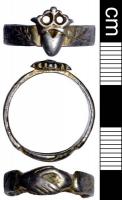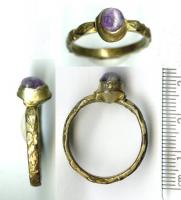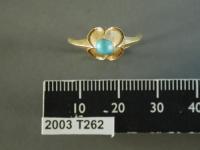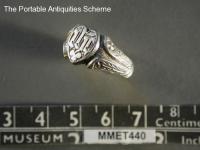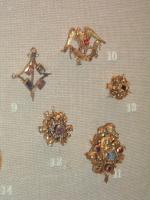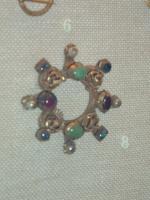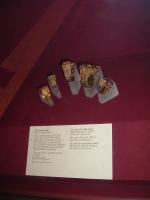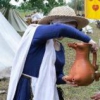
#21

Опубликовано 18 Декабрь 2008 - 20:59
Средневековая Кухня Западной Европы http://vk.com/medieval_cuisine
#22

Опубликовано 19 Декабрь 2008 - 13:53
Средневековая Кухня Западной Европы http://vk.com/medieval_cuisine
#23

Опубликовано 19 Декабрь 2008 - 14:19
http://www.flickr.co...57603077086002/
подписано, как gold fillets - похоже на вещички немок, на статуях в Наубурге (13в) были золотистые головные уборы.
Сначала сделай себе клевый комплект, а ПОТОМ учи на своем примере других.
#24

Опубликовано 19 Декабрь 2008 - 17:18
Средневековая Кухня Западной Европы http://vk.com/medieval_cuisine
#25

Опубликовано 19 Декабрь 2008 - 17:19
2004/T385a
This ring is slightly distorted but measures about 18mm in diameter. The height of the hoop is 4mm. It has two inscriptions; one on its external face, which reads as follows:
mon cuer entier (‘my whole heart’)
and one on the interior:
mon est desr (‘is my desire’)
The latter inscription is puzzling because of the confusing word order. ‘Est mon desr’ would be more logical, assuming ‘desr’ to be an abbreviation of ‘desir’.
2004/T385b
This ring measures 22mm in diameter and 6mm in height. It carries one inscription on its external face, which reads:
mon cuer entier (‘my whole heart’)
The repetition of the legend, combined with their respective sizes, may suggest that the two rings were originally a pair designed for a man and a woman.
2004/T429
This ring measures 17mm in diameter and 4mm in height. It has the following inscription:
nul IB bien
Again, this is puzzling. ‘Nul ce bien’ is a commonplace inscription meaning ‘none so good/ none this good’. The phrase seems to have been personalized either with a monogram or with the initials of two lovers – ‘I B’. It is probably intended to mean something along the lines of ‘none so good as IB or I and B together’.
2004/T430
This ring is badly distorted. It measures 24mm in length and 5mm in height. Its inscription reads:
+ amer et servir (‘ to love and to serve’).
All of the rings are gold and are of fifteenth century date.
The four rings were found in close proximity; two together (2004/T385a&
LATE MEDIEVAL (Certain) to EARLY POST MEDIEVAL (Certain), Circa 1400 AD - Circa 1500 AD
Material: Gold
Width: 5.01 mm
Thickness: 1.64 mm
Diameter: 21.8 mm
Weight: 3.27 grams
Средневековая Кухня Западной Европы http://vk.com/medieval_cuisine
#26

Опубликовано 19 Декабрь 2008 - 22:20
#27

Опубликовано 19 Декабрь 2008 - 22:59
Once Reformation ideas took hold in the sixteenth century, things changed dramatically in England,
and in the Lutheran parts of Germany and the Lowlands. After the banning of rosaries and other
Papist artefacts by Queen Elizabeth in 1571, English recusants continued to illegally import and
make rosaries. Carisbrick suggests they also used the more discreet ‘decade rings’, which can be
worn privily on the finger, or carried in a pouch. They usually have ten small knobs to serve as
beads. The Victoria and Albert Museum holds one, dated 1500 - 1520, which has ten knobs and a
central bevel, which would have taken the place of the gaud on a strung rosary. The bevels of such
rings are often decorated with an initial, possibly that of the owner, or the initial letter of an
appropriate Latin word. Decade rings are sometimes known as ‘soldier’s rosaries’, and have the
added advantage that there is no danger of losing valuable beads if the thread breaks.
http://aelflaed.home.../rosaries2.html
Средневековая Кухня Западной Европы http://vk.com/medieval_cuisine
#28

Опубликовано 20 Декабрь 2008 - 00:18
A medieval silver gilt ring, 15th century. The hoop is formed of two clasped hands and carries the inscription IHC+NAZARENU for ‘Jesus Christ of Nazareth’.
Such rings known as ‘fede’ rings, from the Italian mani in fede (‘hands in faith’), were given as tokens of love, engagement or marriage from Roman times up to the 19th century. A considerable number of ‘fede’ rings have magical inscriptions engraved on the hoop (Oman, C. C. 1993. Victoria and Albert Catalogue of Rings, pages 21-2). There are similar rings in both the Victoria and Albert and the British Museums; one in the Franks Bequest at the BM has a longer inscription, IHC NAZAREN’ R UDEORUM, to which the Cranham inscription clearly refers (Dalton, O. M. 1912. Franks Bequest – Catalogue of the Finger Rings, page 163, ref. 1012). This full inscription is Pilate’s charge against Christ which is given in all four gospels (see for example John 19.19). Its magical significance is explained in the ‘Revelation of the Monk of Evesham’, written in 1196, where the words are said to give protection against sudden death (Oman 1993, page 102).
Parish: UPMINSTER, County: GREATER LONDON
MEDIEVAL (Certain), Circa 1400 AD - Circa 1499 AD
Method of Manufacture: Cast
Material:Silver
Surface Treatment: Gilt
Weight: 5.38 grams The British Museum established the silver content at 93%
Средневековая Кухня Западной Европы http://vk.com/medieval_cuisine
#29

Опубликовано 20 Декабрь 2008 - 00:24
Gold finger-ring, triangular in section. On the inner face is a single engraved 'R'. On the outer two faces are the names of the Three Wise Men; one face has IASPAR: MELChIOR and the other has :BALTAZAR. Before Iaspar is an engraved saltire with a dot in each angle. The ring is large, 20 mm diameter internally and 23 mm diameter externally. The hoop is 3 mm wide and 1.5 mm thick. It is well made and the letters are clearly engraved; the As have a curl at the left-hand end, the M is Lombardic, the Z is crossed and there are serifs. From the form of the lettering it can be dated to the late medieval period. Rings such as these with religious lettering may have been protective or amuletic.
MEDIEVAL (Certain), 1300 AD - 1500 AD
Material:Gold
Width: 3 mm
Thickness: 1.5 mm
Diameter: 23 mm
Weight: 3.17 grams
Средневековая Кухня Западной Европы http://vk.com/medieval_cuisine
#30

Опубликовано 20 Декабрь 2008 - 17:07
Silver finger ring depicting two clasped hands on the front. The ring is inscribed around the outer perimeter 'IHESVS NAZAREN' (Jesus of Nazareth). Rings depicting clasped hands are often classed as 'love/devotional' rings, however the presence of the religious inscription would seem to indicate that the ring was symbolic of the wearers commitment to God.
MEDIEVAL (Certain), Circa 1300 AD - Circa 1499 AD
Method of Manufacture: Cast
Material:Silver
Width: 8 mm
Thickness: 1.2 mm
Diameter: 26 mm
Средневековая Кухня Западной Европы http://vk.com/medieval_cuisine
#31

Опубликовано 20 Декабрь 2008 - 17:12
Средневековая Кухня Западной Европы http://vk.com/medieval_cuisine
#32

Опубликовано 20 Декабрь 2008 - 17:16
LATE MEDIEVAL (Certain), 1400 AD - 1499 AD
Length: 6 mm
Material:Silver
Diameter: 21 mm
Средневековая Кухня Западной Европы http://vk.com/medieval_cuisine
#33

Опубликовано 21 Декабрь 2008 - 03:30
Изольда, спасибо за находку (и спасибо Галине за ссылку на ресурс!). Нижний из филлетов в Эдинбургском музее датируется XII-XIII вв.; насчет остальных не знаю.Попалось на фликре - в той ссылочке, что выложила Галина:
http://www.flickr.co...n_publ...86002/ подписано, как gold fillets - похоже на вещички немок, на статуях в Наубурге (13в) были золотистые головные уборы.
Изменено: Rusia, 21 Декабрь 2008 - 03:32
#34

Опубликовано 06 Март 2009 - 17:22
Средневековая Кухня Западной Европы http://vk.com/medieval_cuisine
#35

Опубликовано 07 Март 2009 - 05:22
кажется, еще не было:
кольца, Швеция:
http://mis.historisk...d.asp?fid=43205
http://mis.historisk...d.asp?fid=43399
http://mis.historisk...d.asp?fid=43399
#36

Опубликовано 07 Март 2009 - 16:05
Средневековая Кухня Западной Европы http://vk.com/medieval_cuisine
#37

Опубликовано 07 Март 2009 - 16:32
sok->foremal

Я искал на "позолоченое серебро", нащел вот эту аллегорию Магистрата Тоже Форума:
http://mis.historisk....asp?uid=328838
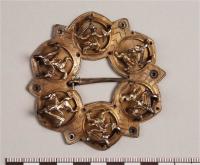
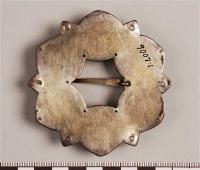
на карточке можно подсмотреть ключевое слово (Sokord):
spänne
ну и модифицируем поиск:

В награду - 121 роскошная застежка, в частности вот эта:
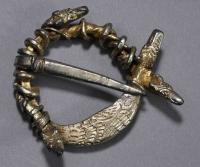
(чтобы увидеть в высоком разрешении, надо щелкнуть на "книжку" в графе "инвентарный номер")
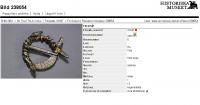
бывают крепости из-за которых не борются; бывают местности, из-за которых не сражаются;
бывают повеления государя, которые не выполняют.
Позитивная вовлечённость в процесс на основе уважения и конструктивности - отличительная черта коммуникаций внутри организации
#38

Опубликовано 07 Март 2009 - 18:03
Средневековая Кухня Западной Европы http://vk.com/medieval_cuisine
#39

Опубликовано 07 Март 2009 - 18:43
бывают крепости из-за которых не борются; бывают местности, из-за которых не сражаются;
бывают повеления государя, которые не выполняют.
Позитивная вовлечённость в процесс на основе уважения и конструктивности - отличительная черта коммуникаций внутри организации
#40

Опубликовано 08 Март 2009 - 20:13
http://mis.historisk...p.asp?uid=44366
http://mis.historisk...p.asp?uid=44368
http://mis.historisk...p.asp?uid=42452
http://mis.historisk...d.asp?uid=44375
http://mis.historisk...d.asp?uid=44401
http://mis.historisk...d.asp?uid=44399
http://mis.historisk...p.asp?uid=44407
http://mis.historisk...p.asp?uid=44409
http://mis.historisk...p.asp?uid=44311
http://mis.historisk....asp?uid=327651
http://mis.historisk....asp?uid=330729
http://mis.historisk....asp?uid=327653
Шикарный пояс, правда уже начала 16в, но в рамки укладывается:
http://mis.historisk...p;typ=fotografi
http://catview.histo...i...&height=779
http://catview.histo...i...&height=779
http://catview.histo...i...&height=779
http://catview.histo...i...&height=779
http://catview.histo...i...&height=779
Средневековая Кухня Западной Европы http://vk.com/medieval_cuisine
Также с меткой «ювелирные изделия, 15 век»
0 пользователей читают эту тему
0 пользователей, 0 гостей, 0 невидимых



